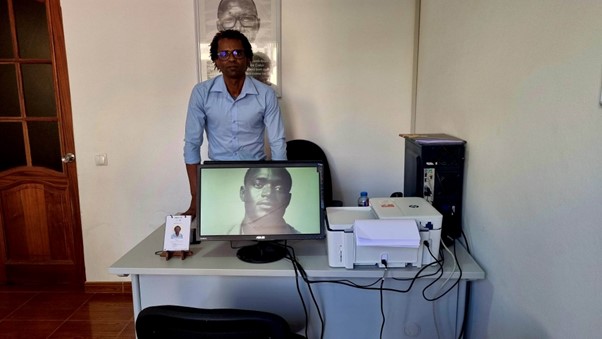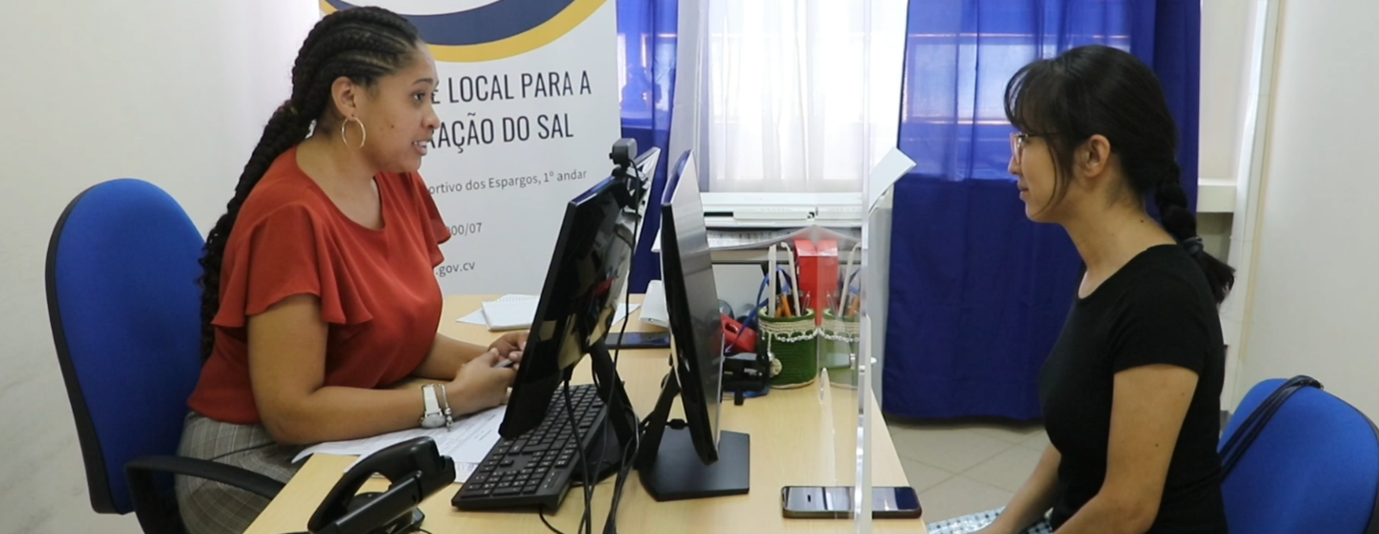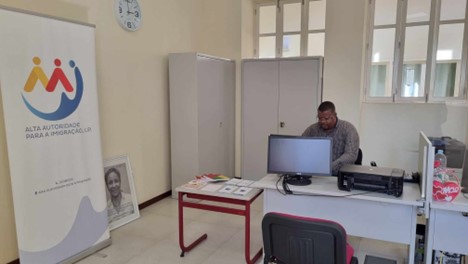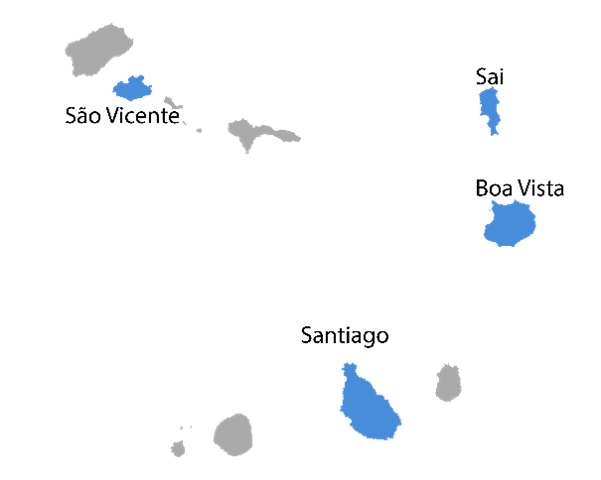Amidst the pressures and tragedies accompanying boat arrivals to the Cabo Verdean islands, the country’s fledging Local Immigration Units (ULIs) have answered the call. Over the past sixteen months, several boats carrying migrants have reached the shores of the islands of Boa Vista, Sal, and São Vincente. In these trying moments, ULIs have emerged as integral pillars, coordinating rescue efforts and providing crucial support to those arriving in dire need.
Established under the ‘Strengthening Migrant Integration through Cooperation between Portugal and Cabo Verde – Coop4Int’ project, funded by the EU through the Migration Partnership Facility (MPF) since December 2021, ULIs are operational in Sal, Boa Vista, Santa Catarina de Santiago, and São Vicente. These units closely collaborate with local councils, serving as extensions of the High Authority for Immigration (AAI) - Cabo Verde’s national institution responsible for overseeing the implementation of the country’s integration policies.
Cabo Verde, an archipelago in West Africa with a population of over half a million people, has historically been known as a country of emigration, with its diaspora doubling the size of its domestic population. However, in recent years, it has increasingly become a destination for migrants from neighbouring ECOWAS countries, Europe, and Asia. Moreover, it has inadvertently become a landing spot for migrants who embarked on precarious and irregular journeys to Europe and who find themselves adrift and arriving on its shores.
As a relatively new recipient of larger immigration flows, Cabo Verde faces significant challenges in developing the necessary institutional structures and policies to support the socioeconomic integration of migrants. According to the 2021 Census by the Foreign and Immigrant Population Survey (2022), conducted by AAI and the National Statistics Institute (INE) of Cabo Verde, there are 10,869 immigrants and foreigners residing in Cabo Verde, representing 2 per cent of the population. The majority are concentrated in the islands of Santiago (44%), Sal (21%), Boa Vista (12%) and São Vicente (11%), with the remaining (12%) distributed among the other islands.
In response to these challenges, ULIs were established to function as centralized hubs or ‘one-stop shops’, with the aim of improving access to information and public services for migrants to facilitate their integration into Cabo Verdean society. They are an integral component of the Coop4Int project, a migration partnership forged between AAI and Portugal’s Agency for Integration, Migration, and Asylum (AIMA) in concert with the Instituto Universitário de Lisboa (ISCTE) and Instituto Politécnico de Bragança (IPB) in Portugal. Drawing upon Portugal’s extensive experience in migrant integration, the partnership involves tailoring strategies and solutions to meet Cabo Verde’s distinct challenges. Portugal’s prior establishment and operation of similar structures to the ULIs, known as Local Centres of Migrants’ Integration Support (CLAIM), underscores the project’s collaborative approach to sharing best practices and successful integration models.
Map of Cabo Verde highlighting the major migrant-receiving islands
One significant and unintended positive consequence of the ULIs has been their role in supporting migrants arriving by boat. They have been essential in facilitating rescues and coordinating assistance to migrants in distress, collaborating closely with national and local institutions, international organisations, and local and migrant communities. This comes on top of their primary and intended mandate of integrating migrants into the country.
The ULIs' handling of boat arrivals is detailed below through firsthand accounts provided by the local officers. These accounts illustrate the instrumental role of ULIs as strategic bridges connecting various stakeholders, showcasing how they have not only brought about tangible change in Cabo Verde’s migrant integration landscape but also acted as catalysts for efficient reception and assistance support for migrants.
Experiences of the ULIs in Dealing with Boat Arrivals
Boa Vista
In January 2023, the Boa Vista ULI was thrust into action when a wooden-style fishing boat known as a ‘pirogue’ washed ashore on the island, carrying 90 survivors in need of urgent assistance.[1] According to the account of the Local Officer from the Boa Vista ULI, Guilherme Monteiro, the boat had set sail from Mauritania and was destined for Europe, specifically the Canary Islands. However, it was blown off course, leading to its unexpected arrival on the island of Boa Vista. The ULI in Boa Vista, newly established and only one week old at the time, swiftly coordinated the rescue and assistance efforts by reaching out to the embassies of the rescued migrants as well as assembled migrant leaders to assist with interpretation. Community donations and relief efforts were urgently called for, focusing on providing essential support such as food, clothing, medical assistance, and shelter. The ULI was also instrumental in securing the local sports centre as an emergency reception site, providing a safe space for rescued migrants.
“It was a shocking event… as just weeks into the ULI opening its doors… we were confronted with the boat arrival…migrants were in a poor state, with many in a state of panic, unaware of where they disembarked"…. Guilherme Monteiro, the Local Officer of the Boa Vista ULI.

Picture of Guilherme Monteiro, Local Officer of the ULI in Boa Vista
Sal
In August 2023, the ULI in Sal was also spurred into action when a Spanish fishing vessel encountered a pirogue adrift in Cabo Verdean territorial waters, prompting an immediate distress call to authorities. The pirogue, carrying 38 survivors and 5 deceased individuals (with 37 being Senegalese and one Guinean), eventually disembarked at the port of Palmera on Sal Island. The ULI in Sal played a crucial role in organising rescue and reception operations and coordination with essential actors in the provision of medical services, food, and shelter. With strong ties to the local migrant community, the ULI harnessed the support of Senegalese residents of the island, who offered interpretation assistance, comfort and solidarity to their fellow compatriots grappling with the trauma of their perilous journey. Led by the efforts of Nademira Silva, the ULI Local Officer in Sal, the Local Unit was instrumental in securing the procurement and delivery of basic necessities, which was funded by IOM.
“The ULI served as a vital bridge connecting migrants to the various emergency responders, facilitating the timely support they urgently needed. Without the ULI coordination among the various actors, the response time would not have been as swift and effective”, remarked the ULI Local Officer of Sal, Nademira Silva.

Picture of Nademira Silva, Local Officer of the ULI in Sal
São Vincente
On March 3rd, 2024, a pirogue arrived on São Vincente Island’s northern beach. Also departing from Mauritania en route to the Spanish Canary Islands, the boat was diverted due to powerful trade winds. The boat’s arrival prompted a coordinated response from AAI, channelled through the ULI. A task force comprising protection officials, firefighters, national police, and the municipality of São Vincente was set up, enabling swift assistance to the arriving migrants.
Three days later, another pirogue arrived in the northern part of the island.
In May 2024, yet another pirogue washed ashore. Once again, the ULI played a pivotal role in the reception of migrants, referring them to primary medical and nutritional care services and organising shelter at a local football stadium.
The Local Officer of the ULI of São Vincente, Ivan Rocha, faced consecutive migrant arrivals by boat and encountered scenes of profound distress and misery. Despite these daunting circumstances, Ivan adeptly navigated through the challenging situation. Witnessing minors and adolescents weakened after enduring days of perilous sailing in unseaworthy boats, some having tragically lost their travelling companions, Ivan, as the lead focal point of the ULI, effectively served as an interlocuter to provide the necessary support for the distressed migrants. In total, 21 survivors were rescued from the three boats, all male, aged between 16 and 23 (19 from Mali, 1 from Senegal and 1 from Mauritania).
“An important aspect is when sheltering the migrants; we mobilised leaders of the Malian migrant community in the island, who were able to communicate with and provide a sense of comfort to the Malian migrants, so they felt safe… this was important as we were dealing with young minors and adolescents, who took incredible lengths and risks to migrate” – ULI Local Officer of São Vincente, Ivan Rocha

Picture of Ivan Rocha, Local Officer of the ULI in São Vincente
ULIs as Vital Anchors in the Cabo Verdean Migration Landscape
ULIs have emerged as essential intermediaries in the socio-economic integration of migrants. Born out of a need to respond agilely and swiftly to rapidly emerging migratory challenges, ULIs have seamlessly integrated themselves into Cabo Verde’s migration ecosystem, positioning themselves at the intersection of public and institutional migration actors, emergency responders, civil society, and migrant communities in Cabo Verde. Their utility in emergency reception and assistance to migrants is enabled by the robust partnerships and trust nurtured by the units, which is an asset not only in working through the myriad of challenges associated with the integration of migrants but also in crisis situations.
Despite being in their infancy, ULIs have swiftly evolved into natural and indispensable ‘strategic bridgers’ in Cabo Verde’s migration landscape. At the helm of the ULIs are local officers, who give personality and character to the units. The challenge of receiving migrants in dire conditions has driven them to rise to the occasion, demonstrating empathy, resilience, and professionalism in guaranteeing conditions of safety, comfort, and care to migrants. The ULIs early success also stems from their incubation under the EU-funded Coop4Int MPF project, which has allowed the leveraging of the Portuguese experience. Yet, the ULIs are charting their own path, attuned to Cabo Verde’s local realities.
Furthermore, the unforeseen positive impacts of ULI involvement in rescue efforts across the islands have not only provided invaluable lessons on crisis management and emergency response coordination but have also underscored the importance of designing institutional structures with the foresight of flexibility. This agility, necessary in adapting to unpredictable and fast-moving environments—especially in a dynamic and rapidly changing domain such as migration—is ingrained in the ULI's institutional DNA.
Acknowledged as indispensable by migration actors in the country, ULIs are poised to remain essential cogs in both the emergency and non-emergency migration contexts in Cabo Verde. Their journey and ongoing evolution are intricately linked to Cabo Verde’s progress in effectively managing migration as a country straddling a strategic oceanic crossroads between Europe, Western Africa, and the Atlantic.
[1] Of which 56 were from Senegal, 26 from Gambia, 5 from Guinea-Bissau, 2 from Sierra Leone, 1 from Guinea-Conakry, and 1 from Mali.

